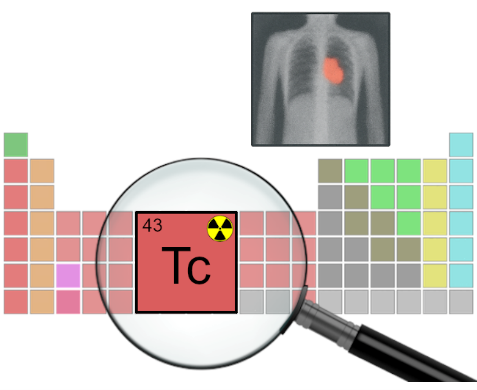Abstract
Technetium (Tc) is a metallic element with atomic number 43, which occupies the group 7 and period 5 in the periodic table. It was not properly identified until 1937, when Carlo Perrier and Emilio Segre characterized it as a product of nuclear reactions in the recently invented cyclotron. Its chemistry is rich and versatile due to the large number of existing compounds and complexes, especially with oxidation state +7. Its main application is in medical imaging, such as tomography and scintigraphy. For this purpose, the isotope 99mTc is widely used. It is also employed in the manufacture of alloys and as a catalyst. Despite being considered a synthetic element, it can be found in nature but only in trace amounts.
References
R. Zingales, J. Chem. Educ. 2005 82 221-227, https://doi.org/10.1021/ed082p221.
H. K. Yoshihara, Spectrochim. Acta A Mol. Biomol. Spectrosc. 2004, 59, 1305-1310, https://doi.org/10.1016/j.sab.2003.12.027.
W. Noddack, I. Tacke, O. Berg, Naturwissenschaften 1925 13 567–574, https://doi.org/10.1007/BF01558746.
F. A. A. de Jonge, E. K. J. Pauwels, Eur. J. Nucl. Med. 1996 23 336–344, https://doi.org/10.1007/BF00837634.
C. Perrier, E. Segrè, Nature 1937, 140, 193, https://doi.org/10.1038/140193b0.
C. Perrier, E. Segrè, J. Chem. Phys. 1937 5 712-716 https://doi.org/10.1063/1.1750105.
R. C. L. Mooney, Acta Cryst. 1948 1, 161-162, https://doi.org/10.1107/S0365110X48000466.
L. E. Burkhart, W. F. Peed, B. G. Saunders, Phys. Rev. 1948 73, 347-349, https://doi.org/10.1103/PhysRev.73.347.
K. Schwochau, Technetium: Chemistry and Radiopharmaceutical Applications. Wiley-VCH (2000) https://doi.org/10.1002/9783527613366.
E. Segrè, G. T. Seaborg, Phys. Rev. 1938 54 772 https://doi.org/10.1103/PhysRev.54.772.2.
G. T. Seaborg, E. Segrè, Phys. Rev. 1939 55 808-814 https://doi.org/10.1103/PhysRev.55.808.
M. Riondato, D. Rigamonti, P. Martini, C. Cittanti, A. Boschi, L. Urso, L. Uccelli, J. Med. Chem. 2023, 66, 14582, https://doi.org/10.1021/acs.jmedchem.3c00148.
S. Zhang, X. Wang, X. Gao, X. Chen, L. Li, G. Li, C. Liu, Y. Miao, R. Wang, K. Hu, Signal Transduct. Target. Ther. 2025, 10, 1, https://doi.org/10.1038/s41392-024-02041-6.
K. Mado, Y. Ishii, T. Mazaki, M. Ushio, H. Masuda, T. Takayama, World J. Surg. Onc. 2006, 4, 3, https://doi.org/10.1186/1477-7819-4-3.
E. Segrè, C. S. Wu, Phys. Rev. 1940 57 552 https://doi.org/10.1103/PhysRev.57.552.3.
M. García-León, J. Nucl. Radiochem. Sci. 2005, 6, 253-259, https://doi.org/10.14494/jnrs2000.6.3_253.
P. W. Merrill, Astrophys. J. 1952 116 21, https://doi.org/10.1086/145589.

This work is licensed under a Creative Commons Attribution-NonCommercial-ShareAlike 4.0 International License.
Copyright (c) 2025 Anales de Química de la RSEQ


